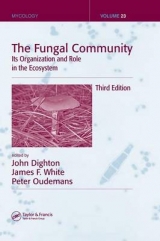
The Fungal Community
Marcel Dekker Inc (Verlag)
978-0-8247-8605-2 (ISBN)
- Titel erscheint in neuer Auflage
- Artikel merken
Entirely rewritten and updated throughout, this Second Edition maintains and enhances the features of the first edition. The Fungal Community, Second Edition continues to cover the entire spectrum of fungal ecology, from studies of individual fungal populations to the functional role of fungi at the ecosystem level, and to present mycological ecology as a rational, organized body of knowledge.;Acting as a bridge between mycological data and ecological theory, The Fungal Community, Second Edition offers such new features as an emphasis on the nonequilibrium perspective, including the impact of habitat disturbance and environmental stress; more information on the ecological genetics of fungal populations; a chapter on the fitness of genetically altered fungi when released into the environment; an examination of fungal morphological and physiological adaptations from the evolutionary ecologist's point-of-view; an explication of the effect of fungi and insect interactions on fungal community structure and decomposition processes; a section on the importance of fungi in determining patterns of plant community development; and a chapter on modeling fungal contributions to decomposition and nutrient cycling in ecosystems.;With over 3700 references, The Fungal Community, Second Edition is a resource for mycologists; microbial ecologists; microbiologists; geneticists; virologists; plant pathologists; cell and molecular biologists; biotechnologists; soil, forest, and environmental scientists; and graduate-level students in these disciplines.
Part 1 Fungal ecology and ecological theory - non-equilibrium themes for ecological theory - implications for fungal communities; the ties that bind - fungi in ecosystems. Part 2 Fungal populations, environmental parameters, and the niche concept - the niche at the organismal level - lichen photosynthetic responses; anaerobic fungi and the rumen ecosystem; fitness of genetically altered fungi. Part 3 The organization of fungal populations and communities - fungal life-history strategies; dispersal of fungal diaspores; the growth and regulation of pathogenic fungal populations; diversity within populations of fungal pathogens on perennial parts of perennial plants; analysis of fungal population structure using molecular techniques; multivariate analysis in fungal ecology. Part 4 Special interactions in fungal communities - introduction to the theory of species interactions; exploitation competition; interference competition; mycoparasitism of soilborne plant pathogens; fungi, fungivores, and fungal food webs; lignolytic and cellulolytic fungi as predators and parasites; fungal mutualism. Part 5 Fungal community development - patterns of phenology in populations of zoosporic fungi; mechanisms in fungal succession; response of soil fungal communities to disturbance; experimental disturbances and epigeous fungi. Part 6 Fungal influences on plant community dynamics - mycorrhizae and plant community development - mechanisms and patterns; fungal pathogens and the structure of plant populations and communities; plant pathogens and long-term ecosystem changes. Part 7 Fungal biomass and productivity in ecosystems - estimating fungal biomass and productivity in decomposing litter; sporocarp production by basidiomycetes, with emphasis on forest ecosystems; epiphytic lichen biomass. Part 8 Fungi in nutrient cycling - the impact of fungi on environment biogeochemistry; the functional groups of microfungi in decomposition; the mycorrhizal fungal community with special reference to nutrient mobilization; the role of fungi in litter decomposition and nutrient cycling; interactions between invertebrates and fungi - effects on nutrient availability; modeling the contributions of decomposer fungi in nutrient cycling. Part 9 Mycological systems for examining ecological ideas - the coprophilous fungal community - an experimental system; aquatic hyphomycete communities; development and function of fungal communities in decomposing wood. Part contents.
| Reihe/Serie | Mycology |
|---|---|
| Verlagsort | New York |
| Sprache | englisch |
| Gewicht | 1950 g |
| Themenwelt | Naturwissenschaften ► Biologie ► Mikrobiologie / Immunologie |
| Naturwissenschaften ► Biologie ► Ökologie / Naturschutz | |
| ISBN-10 | 0-8247-8605-X / 082478605X |
| ISBN-13 | 978-0-8247-8605-2 / 9780824786052 |
| Zustand | Neuware |
| Haben Sie eine Frage zum Produkt? |
aus dem Bereich



